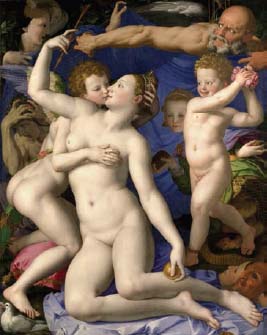The Early Modern World, C. 1300–1600Sixteenth-Century European Art and Architecture |
What is Mannerism? |
While many of the most successful artists of the early sixteenth century followed the Classical aesthetic so popular during the Renaissance, not everyone did. Overall, Renaissance artists valued naturalistic representations of the ideal human, both physically and mentally, and art with balanced, symmetrical, and proportionate forms. It can come as a shock, therefore, to see work such as Bronzino’s Allgeory with Venus and Cupid, an erotic and slightly disturbing painting of Venus kissing her son, Cupid. The painting is filled with twisted, elongated figures. They appear weightless, limbs seem attached at odd angles, and the colors are off. Behind Cupid’s contorted body, a woman screams, grabbing her hair. To the right, a cherub hurls flowers like a weapon. At his feet, theatrical masks depict ugly faces.
Although Allegory with Venus and Cupid may be a sensational example, it is certainly not the only early sixteenth-century painting to exhibit such anomalies of naturalism. Other artists, including Pon-tormo, Parmigianino, and Benvenuto Cellini, favored what is known as the “mannerist” style in Italy. The definition of mannerism is controversial, but it is generally thought of as an intellectual and rebellious alternative to the refined styles of High Renaissance. It is characterized by elongated figures in unstable poses, the use of pastel colors, and sometimes, sexual overtones. Mannerist art was popular amongst courtly, rather than religious, patrons. While the style developed in Italy, it was also popular in Northern Europe.

A strange and enigmatic art movement called Mannerism was popular amongst courtly artists who wished to differentiate themselves from the stoic masters of the High Renaissance. The Mannerist artist Bronzino painted An Allegory with Venus and Cupid in approximately 1545. The painting features a constricted, awkward sense of space, unusually twisting figures, and mysterious faces looming in the background.
